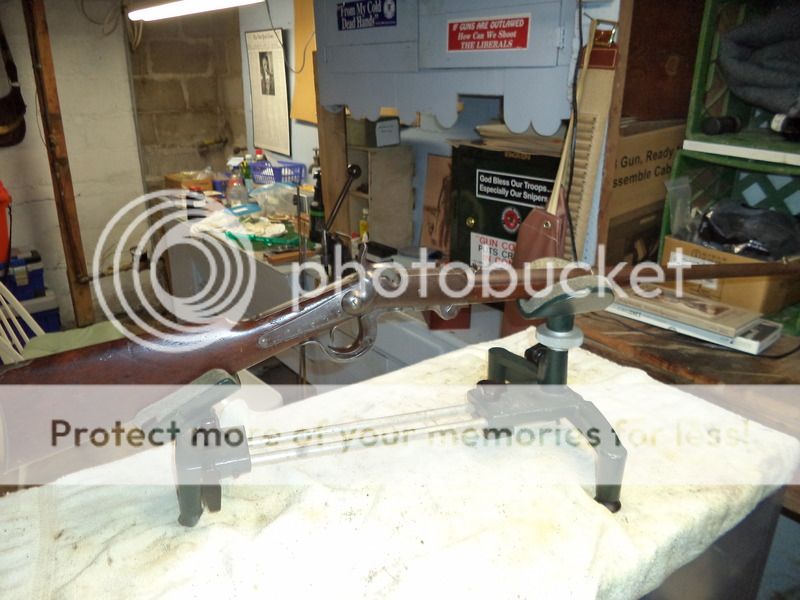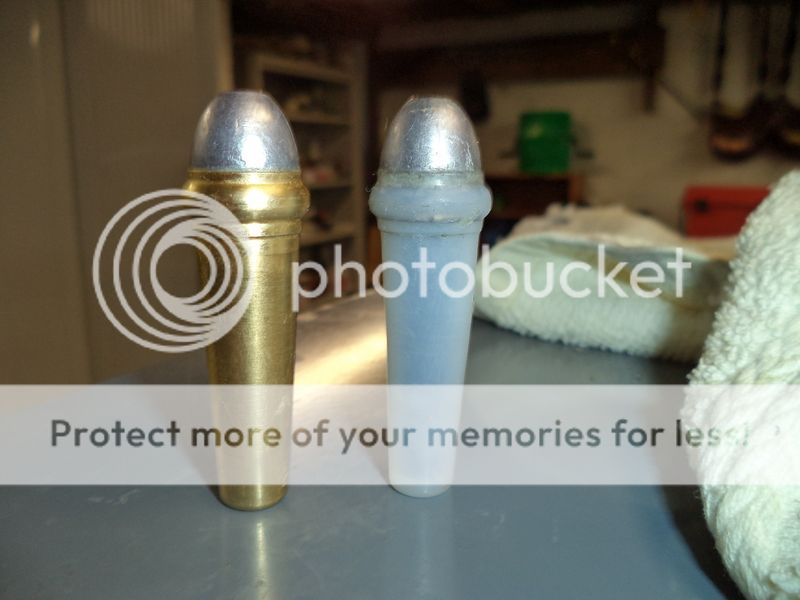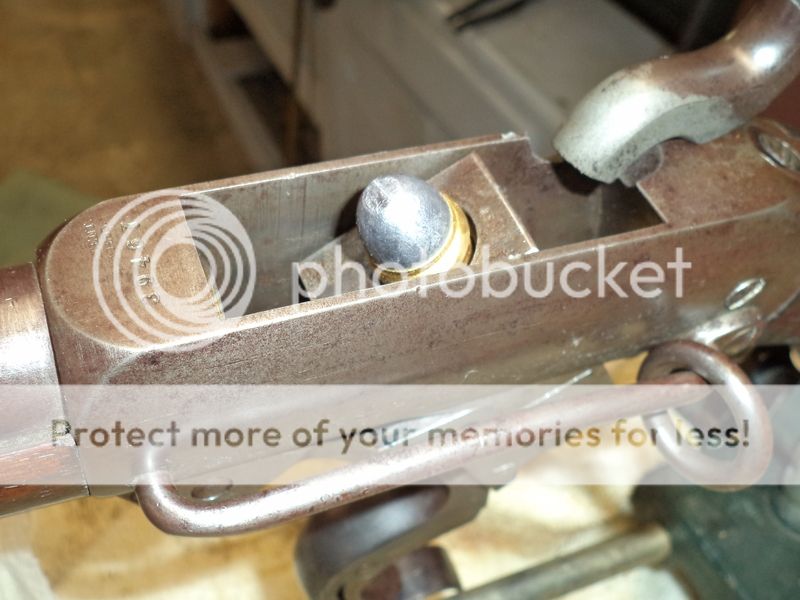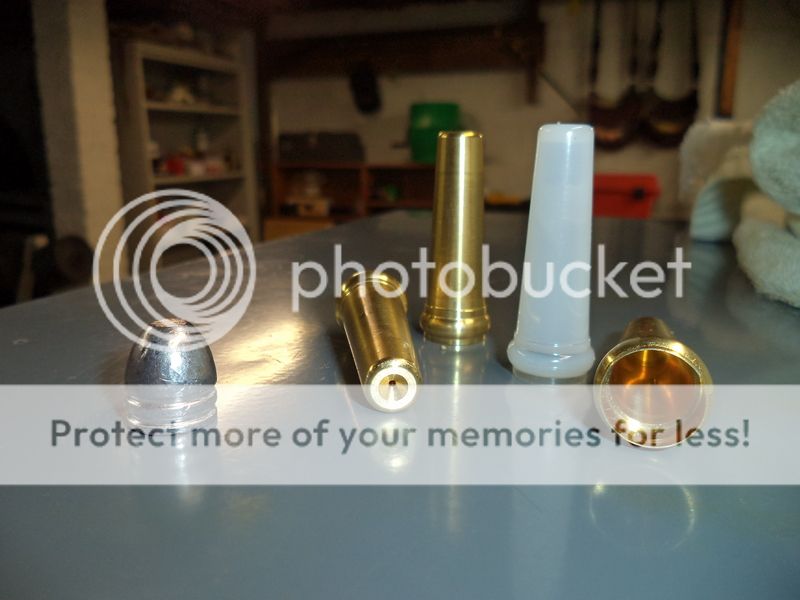The Goose
NES Member
Check out the write up I did in the Reloading forum for more info on this unique rifle and round. However, this is the range report and I figured it belonged here. This is a 3rd Model Burnside .54 cavalry carbine made about 1862 and saw service in the Civil War.

I had made up 30 rounds, 10 brass cased and 20 nylon cased. I set up a large Shoot N C 12" target at 50 yards. I loaded a brass cased cartridge into the breech block, put a musket cap on the percussion nipple and took my first shot. My experience with 19th century military rifles is that they usually shoot anywhere from 6" - 12" high at 50 yards so I aimed at the bottom (6:00) of the 12" circle and fired. The bullet cut the very base of the black right at 6:00. After that I pretty much aimed dead center. I fired 5 shot groups and then changed out the target. The groups ranged from 6" - 8" or so. Personally I call that good for what it is. The brass and nylon cases shot pretty much the same.
What really impressed me was the ease of operation and the reliability. Although there is no extractor or ejector the spent case pulled out effortlessly and the new one slid right in. The rifle functioned perfectly for all 30 rounds. The little carbine handled well and went to the shoulder well. Recoil was mild. Compared to the muzzle loaders of the day this little guy was fast. It was the third most popular breech loader after the Sharps and the Spencer and was considered to be accurate and reliable.
The really cool thing was the incredible sense of history that I felt shooting this rifle. Some cavalryman actually carried this carbine into combat. I cannot describe the thrill that I got shooting this rifle for the first time. With a little research I could probably find out what regiment it was used by. They were not popular after the war and the unique ammunition became harder and harder to find. It is likely that this old carbine had not been fired since the Civil War and at the very least not for the last 100 years. Although there are quite a few Burnsides floating around these days there were only 1500 of these 3rd models and they were all under government contract and were issued at height of the war. The machining, fit and finish of this carbine is remarkable given the tools of the day and that they were literally working around the clock trying to pump out firearms for the war effort.
Below is a photo of the loaded rounds and how they chamber. I suppose that the Spencer or the Henry had the advantage of magazine capacity and rapidity of fire, but the Burnside, back in the day, was no slouch. What a remarkable piece of history.



I had made up 30 rounds, 10 brass cased and 20 nylon cased. I set up a large Shoot N C 12" target at 50 yards. I loaded a brass cased cartridge into the breech block, put a musket cap on the percussion nipple and took my first shot. My experience with 19th century military rifles is that they usually shoot anywhere from 6" - 12" high at 50 yards so I aimed at the bottom (6:00) of the 12" circle and fired. The bullet cut the very base of the black right at 6:00. After that I pretty much aimed dead center. I fired 5 shot groups and then changed out the target. The groups ranged from 6" - 8" or so. Personally I call that good for what it is. The brass and nylon cases shot pretty much the same.
What really impressed me was the ease of operation and the reliability. Although there is no extractor or ejector the spent case pulled out effortlessly and the new one slid right in. The rifle functioned perfectly for all 30 rounds. The little carbine handled well and went to the shoulder well. Recoil was mild. Compared to the muzzle loaders of the day this little guy was fast. It was the third most popular breech loader after the Sharps and the Spencer and was considered to be accurate and reliable.
The really cool thing was the incredible sense of history that I felt shooting this rifle. Some cavalryman actually carried this carbine into combat. I cannot describe the thrill that I got shooting this rifle for the first time. With a little research I could probably find out what regiment it was used by. They were not popular after the war and the unique ammunition became harder and harder to find. It is likely that this old carbine had not been fired since the Civil War and at the very least not for the last 100 years. Although there are quite a few Burnsides floating around these days there were only 1500 of these 3rd models and they were all under government contract and were issued at height of the war. The machining, fit and finish of this carbine is remarkable given the tools of the day and that they were literally working around the clock trying to pump out firearms for the war effort.
Below is a photo of the loaded rounds and how they chamber. I suppose that the Spencer or the Henry had the advantage of magazine capacity and rapidity of fire, but the Burnside, back in the day, was no slouch. What a remarkable piece of history.



